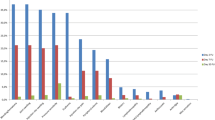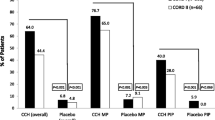Abstract
Background
Collagenase Clostridium histolyticum (CCH) is a recent treatment for Dupuytren disease, which is a fibroproliferative disorder that leads to progressive, persistent digital flexion contracture that interferes with basic daily activities. While CCH has changed the treatment of this hand disorder, numerous concerns have to be analyzed.
Aims
Our purpose is to assess the current status of this medical treatment.
Methods
Literary review based on a manual search on PubMed, Web of Science, and Google Academic.
Results
Pharmacoeconomic analyses support the use of CCH, but long-term studies showing that it should be favored over conventional surgery or other treatments are lacking. Treatment decisions, therefore, must be guided by current data, which include a 5-year recurrence rate of 47%. Complications following CCH treatment are also a controversial topic, as rates of over 90% have been reported, although most of the complications are mild and self-limiting. A definition and classification of CCH-related complications is sorely needed. If we exclude adverse effects that could be considered inherent to the mechanisms of action of CCH, then the complication rate would be similar to rates reported for other techniques. Although CCH is becoming an increasingly popular treatment for Dupuytren disease, the potential applications of this modality, are much higher than currently believed, for more disorders characterized by excessive fibrosis.
Conclusion
Currently, the administration of this treatment is promising although long-term studies are necessary to see the real role that this drug can play in both Dupuytren’s disease and other fibrotic disorders.
Similar content being viewed by others
References
Dibenedetti DB, Nguyen D, Zografos L et al (2011) Prevalence, incidence, and treatments of Dupuytren’s disease in the United States: results from a population-based study. Hand N Y N 6:149–158
Shih B, Watson S, Bayat A (2012) Whole genome and global expression profiling of Dupuytren’s disease: systematic review of current findings and future perspectives. Ann Rheum Dis 71:1440–1447
Brickley-Parsons D, Glimcher MJ, Smith RJ et al (1981) Biochemical changes in the collagen of the palmar fascia in patients with Dupuytren’s disease. J Bone Jt Surg Am 63:787–797
Hinz B, Phan SH, Thannickal VJ et al (2007) The myofibroblast: one function, multiple origins. Am J Pathol 170:1807–1816
Hueston JI (1992) Lessons in Dupuytren’s disease. Ann Chir Main Memb Supér 11:349–354
Clarkson P (1963) The radical fasciectomy operation for Dupuytren’s disease: a condemnation. Br J Plast Surg 16:273–279
Lermusiaux J-L, Badois F, Lellouche H (2001) Maladie de Dupuytren. Rev Rhum 68:542–547
Dias J, Bainbridge C, Leclercq C et al (2013) Surgical management of Dupuytren’s contracture in Europe: regional analysis of a surgeon survey and patient chart review. Int J Clin Pract 67:271–281
Duarte AS, Correia A, Esteves AC (2016) Bacterial collagenases - a review. Crit Rev Microbiol 42:106–126
Worthington V Collagenase - Worthington Enzyme Manual. Worthington Enzyme Manual, Worthington K, Worthington V (2011) Worthington Biochemical Corporation., http://www.worthington-biochem.com/cls/default.html (2011, accessed 20 August 2017).
Hoogerheide JC (1937) Variability in morphological and biochemical properties of Clostridium histolyticum (Weinberg and Seguin). J Bacteriol 34:387–407
Bond MD, Van Wart HE (1984) Characterization of the individual collagenases from Clostridium histolyticum. Biochemistry 23:3085–3091
Bond MD, Van Wart HE (1984) Purification and separation of individual collagenases of Clostridium histolyticum using red dye ligand chromatography. Biochemistry 23:3077–3085
Bond MD, Van Wart HE (1984) Relationship between the individual collagenases of Clostridium histolyticum: evidence for evolution by gene duplication. Biochemistry 23:3092–3099
Sanjuan-Cerveró R, Gomez-Herrero D, Carrera-Hueso FJ (2016) Mechanism of action of collagenase clostridium histolyticum for clinical application. Eur J Clin Pharm Aten Farm 18:8–8
Bromley JW, Hirst JW, Osman M, Steinlauf P, Gennace RE, Stern H (1980) Collagenase: an experimental study of intervertebral disc dissolution. Spine 5:126–132
Gelbard MK, Walsh R, Kaufman JJ (1982) Collagenase for Peyronie’s disease experimental studies. Urol Res 10:135–140
Badalamente MA, Hurst LC Collagenase: preclinical evaluation and clinical trials in the USA and Australia. In: Collagenase in Dupuytren Disease. Springer, Cham, pp 7–16
Badalamente MA, Hurst LC (2018) Development of collagenase treatment for Dupuytren disease. Hand Clin 34:345–349
Hurst LC, Badalamente MA, Hentz VR, Hotchkiss RN, Kaplan FT, Meals RA, Smith TM, Rodzvilla J, CORD I Study Group (2009) Injectable collagenase Clostridium histolyticum for Dupuytren’s contracture. N Engl J Med 361:968–979
Gilpin D, Coleman S, Hall S et al (2010) Injectable collagenase Clostridium histolyticum: a new nonsurgical treatment for Dupuytren’s disease. J Hand Surg 35:2027-2038.e1
Peimer CA, Skodny P, Mackowiak JI (2013) Collagenase Clostridium histolyticum for Dupuytren contracture: patterns of use and effectiveness in clinical practice. J Hand Surg 38:2370–2376
Peimer CA, Blazar P, Coleman S et al (2015) Dupuytren contracture recurrence following treatment with collagenase Clostridium histolyticum (CORDLESS [Collagenase Option for Reduction of Dupuytren Long-Term Evaluation of Safety Study]): 5-year data. J Hand Surg 40:1597–1605
Warwick D, Arner M, Pajardi G et al (2015) Collagenase clostridium histolyticum in patients with Dupuytren’s contracture: results from POINT X, an open-label study of clinical and patient-reported outcomes. J Hand Surg Eur Vol 40:124–132
Hirata H, Tanaka K, Sakai A et al (2016) Efficacy and safety of collagenase Clostridium histolyticum injection for Dupuytren’s contracture in non-Caucasian Japanese patients (CORD-J Study): the first clinical trial in a non-Caucasian population. J Hand Surg Eur Vol 42:30–38
Bebbington E, Furniss D (2015) Linear regression analysis of Hospital Episode Statistics predicts a large increase in demand for elective hand surgery in England. J Plast Reconstr Aesthet Surg 68:243–251
Chen NC, Shauver MJ, Chung KC (2011) Cost-effectiveness of open partial fasciectomy, needle aponeurotomy, and collagenase injection for Dupuytren contracture. J Hand Surg 36:1826-1834.e32
Malone DC, Armstrong EP (2012) PMS29 Cost-Effectiveness of collagenase Clostridium histolyticum, limited fasciectomy, and percutaneous needle fasciotomy in the treatment of Dupuytren’s contracture. Value Health 15:A38–A39
Baltzer H, Binhammer PA (2013) Cost-effectiveness in the management of Dupuytren’s contracture a Canadian cost-utility analysis of current and future management strategies. Bone Jt J 95-B:1094–1100
Sanjuan-Cervero R, Franco-Ferrando N, Poquet-Jornet JE et al Short-term cost-utility analysis of collagenase versus fasciectomy for Dupuytren contracture. In: Dupuytren Disease and Related Diseases - The Cutting Edge. Springer, Cham, pp 271–275
Murphy LE, Murphy KM, Kilpatrick SM et al (2017) The use of collagenase Clostridium histolyticum in the management of Dupuytren’s contracture-outcomes of a pilot study in a district general hospital setting. Ulst Med J 86:94–98
Dritsaki M, Rivero-Arias O, Gray A et al (2018) What do we know about managing Dupuytren’s disease cost-effectively? BMC Musculoskelet Disord 19:34
Sanjuan-Cerveró R, Franco-Ferrando N, Poquet-Jornet J (2013) Use of resources and costs associated with the treatment of Dupuytren’s contracture at an orthopedics and traumatology surgery department in Denia (Spain): collagenase clostridium hystolyticum versus subtotal fasciectomy. BMC Musculoskelet Disord 14:293
Leskelä R-L, Herse F, Torkki P et al (2016) Analysis of the adoption of new health technology: the case of Dupuytren’s disease. Int J Healthc Technol Manag 15:210–227
Sanjuan-Cerveró R, Vazquez-Ferreiro P, Gomez-Herrero D et al (2017) Efficacy of collagenase Clostridium histolyticum for Dupuytren disease: a systematic review. Rev Iberoam Cir Mano 45:070–088
Warwick D Collagenase: what we may never know (a discussion). In: PMN W, Dias J, Eaton C et al (eds) Dupuytren Disease and Related Diseases - The Cutting Edge. Springer International Publishing, pp 145–149
Jupiter J, Burke D (2013) Scott’s parabola and the rise of the medical–industrial complex. Hand N Y N 8:249–252
Scott JW (2001) Scott’s parabola. BMJ 323:1477
Arandes-Renú JM, Sanjuán-Cerveró R, Moya-Molinas I Collagenase in Europe from the experimental phase to practical use. In: Pajardi G, Badalamente MA, Hurst LC (eds) Collagenase in Dupuytren Disease. Springer International Publishing, Cham, pp 39–74
Sanjuan-Cerveró R, Carrera-Hueso FJ, Vazquez-Ferreiro P et al (2017) Adverse effects of collagenase in the treatment of Dupuytren disease: a systematic review. BioDrugs Clin Immunother Biopharm Gene Ther 31:105–115
Peimer CA, Wilbrand S, Gerber RA et al (2015) Safety and tolerability of collagenase Clostridium histolyticum and fasciectomy for Dupuytren’s contracture. J Hand Surg Eur Vol 40:141–149
Lewallen LW, Rizzo M (2017) Phalangeal fracture during attempted Dupuytrens release following clostridial collagenase injection: case report. J Orthop Case Rep 7:21–24
Sanjuan-Cerveró R, Franco N (2014) Vasospasm after collagenase Clostridium histolyticum infiltration in Dupuytren’s contracture. Int J Med Pharm Case Rep 1:42–48
Wozniczka J, Canepa C, Mirarchi A et al (2017) Complications following collagenase treatment for Dupuytren contracture. HAND 1558944717711461
Eaton C Controversy: the contracture in Dupuytren disease is a passive process. In: Werker PMN, Dias J, Eaton C et al (eds) Dupuytren Disease and Related Diseases - The Cutting Edge. Springer International Publishing, pp 89–96
Hurst L Dupuytre's contracture. In: Green’s Operative Hand Surgery. Churchill Livingstone, Edimburg, pp 141–158
Hohendorff B, Spies CK, Müller LP, Ries C (2016) Supplementary arthrolysis of the proximal interphalangeal finger joint in Dupuytren’s contracture: primary operation versus revision. Arch Orthop Trauma Surg 136:435–439
Sanjuan-Cerveró R, Carrera-Hueso FJ, Vazquez-Ferreiro P et al (2018) Efficacy and adverse effects of collagenase use in the treatment of Dupuytren’s disease: a meta-analysis. Bone Jt J 100-B:73–80
Peimer CA, Blazar P, Coleman S et al (2013) Dupuytren contracture recurrence following treatment with collagenase Clostridium histolyticum (CORDLESS Study): 3-year data. J Hand Surg 38:12–22
Warwick D (2017) Dupuytren’s disease: my personal view. J Hand Surg Eur Vol 42:665–672
Wilbrand S Collagenase: future perspectives. In: Pajardi G, Badalamente MA, Hurst LC (eds) Collagenase in Dupuytren Disease. Springer International Publishing, Cham, pp 131–142
Hutchinson JW, Tierney GM, Parsons SL et al (1998) Dupuytren’s disease and frozen shoulder induced by treatment with a matrix metalloproteinase inhibitor. J Bone Joint Surg Br 80-B:907–908
Badalamente MA, Wang ED CORR(®) ORS Richard A. Brand award: clinical trials of a new treatment method for adhesive capsulitis. Clin Orthop. Epub ahead of print 9 May 2016. https://doi.org/10.1007/s11999-016-4862-8
Diehm YF, Hirche C, Berger MR et al The collagenase of the bacterium Clostridium histolyticum in the treatment of irradiation-induced capsular contracture. Aesthetic Plast Surg. Epub ahead of print 19 November 2018. https://doi.org/10.1007/s00266-018-1267-y
Fischer S, Diehm Y, Henzler T, Berger MR, Kolbenschlag J, Latz A, Bueno EM, Hirche C, Kneser U, Pomahac B (2017) Long-Term Effects of the Collagenase of the Bacterium Clostridium histolyticum for the Treatment of Capsular Fibrosis After Silicone Implants. Aesthetic Plast Surg 41:211–220
Badalemente MA, Wang E (2009) Methods for treatment using collagenase. 20090010918, http://www.freepatentsonline.com/y2009/0010918.html (accessed 21 October 2017).
Varga J, Pasche B (2008) Anti-TGF-ß Therapy in Fibrosis: recent progress and implications for systemic sclerosis. Curr Opin Rheumatol 20:720–728
Zhou C, Liu F, Gallo PH et al (2016) Anti-fibrotic action of pirfenidone in Dupuytren’s disease-derived fibroblasts. BMC Musculoskelet Disord 17:469
Villegas MR, Baeza A, Usategui A et al Collagenase nanocapsules: an approach to fibrosis treatment. Acta Biomater. Epub ahead of print 4 May 2018. https://doi.org/10.1016/j.actbio.2018.05.007
Pan A, Wang Z, Chen B, Dai W, Zhang H, He B, Wang X, Wang Y, Zhang Q (2018) Localized co-delivery of collagenase and trastuzumab by thermosensitive hydrogels for enhanced antitumor efficacy in human breast xenograft. Drug Deliv 25:1495–1503
Author information
Authors and Affiliations
Corresponding author
Ethics declarations
Conflict of interest
The authors declare that they have no conflict of interest.
Ethical statement
Research involving human participants and/or animals review. Non clinical study.
Informed consent
Not necessary. Review article made without patients participation. Non clinical study.
Additional information
Publisher’s note
Springer Nature remains neutral with regard to jurisdictional claims in published maps and institutional affiliations.
Rights and permissions
About this article
Cite this article
Sanjuan-Cervero, R. Current role of the collagenase Clostridium histolyticum in Dupuytren’s disease treatment. Ir J Med Sci 189, 529–534 (2020). https://doi.org/10.1007/s11845-019-02127-z
Received:
Accepted:
Published:
Issue Date:
DOI: https://doi.org/10.1007/s11845-019-02127-z




